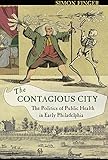The Contagious City : The Politics of Public Health in Early Philadelphia / Simon Finger.
Material type: TextPublisher: Ithaca, NY : Cornell University Press, [2012]Copyright date: ©2012Description: 1 online resource (246 p.) : 10 halftones, 1 chart/graphContent type:
TextPublisher: Ithaca, NY : Cornell University Press, [2012]Copyright date: ©2012Description: 1 online resource (246 p.) : 10 halftones, 1 chart/graphContent type: - 9780801464003
- Communicable diseases -- Political aspects -- History -- 18th century -- Pennsylvania -- Philadelphia
- Communicable diseases -- Political aspects -- Pennsylvania -- Philadelphia -- History -- 18th century
- Public health -- Political aspects -- History -- 18th century -- Pennsylvania -- Philadelphia
- Public health -- Political aspects -- Pennsylvania -- Philadelphia -- History -- 18th century
- Social medicine -- History -- 18th century -- Pennsylvania -- Philadelphia
- Social medicine -- Pennsylvania -- Philadelphia -- History -- 18th century
- U.S. History
- Urban Studies
- HISTORY / United States / State & Local / Middle Atlantic (DC, DE, MD, NJ, NY, PA)
- william penn, city life and health, disease in cities, colonial life, american medical history, american colonization, medicine and politics
- 362.10974811 23
- RA448.P45 F56 2016
- online - DeGruyter
| Item type | Current library | Call number | URL | Status | Notes | Barcode | |
|---|---|---|---|---|---|---|---|
 eBook
eBook
|
Biblioteca "Angelicum" Pont. Univ. S.Tommaso d'Aquino Nuvola online | online - DeGruyter (Browse shelf(Opens below)) | Online access | Not for loan (Accesso limitato) | Accesso per gli utenti autorizzati / Access for authorized users | (dgr)9780801464003 |
Frontmatter -- Contents -- Preface -- Acknowledgments -- Introduction: Epidemic Constitutions -- 1. “A Rude Place and an Unpolisht Man”: William Penn and the Nature of Pennsylvania -- 2. “An Infancy of Government”: Population, Authority, and the Problem of Proprietorship -- 3. “A Suitable Charity or an Effectual Security”: Community, Contagion, and the Care of Strangers -- 4. “A Body Corporate and Politick”: Association, Interest, and Improvement in a Provincial City -- 5. “Improvement in Every Part of the Healing Art”: Transatlantic Cultures of Medical Improvement -- 6. “A Fine Field for Professional Improvement”: Sites and Sources of Medical Authority in the Revolutionary War -- 7. “In a Yielding State”: Nervous Nationalism in the New Republic -- 8. “Those Friendly Reciprocities”: Panic and Participation in the Age of Yellow Fever -- 9. “A Matter of Police”: Fever and Betrayal in the Federal Union -- Conclusion: Looking West from Philadelphia -- Notes -- Index
restricted access online access with authorization star
http://purl.org/coar/access_right/c_16ec
By the time William Penn was planning the colony that would come to be called Pennsylvania, with Philadelphia at its heart, Europeans on both sides of the ocean had long experience with the hazards of city life, disease the most terrifying among them. Drawing from those experiences, colonists hoped to create new urban forms that combined the commercial advantages of a seaport with the health benefits of the country. The Contagious City details how early Americans struggled to preserve their collective health against both the strange new perils of the colonial environment and the familiar dangers of the traditional city, through a period of profound transformation in both politics and medicine.Philadelphia was the paramount example of this reforming tendency. Tracing the city’s history from its founding on the banks of the Delaware River in 1682 to the yellow fever outbreak of 1793, Simon Finger emphasizes the importance of public health and population control in decisions made by the city’s planners and leaders. He also shows that key figures in the city’s history, including Benjamin Franklin and Benjamin Rush, brought their keen interest in science and medicine into the political sphere. Throughout his account, Finger makes clear that medicine and politics were inextricably linked, and that both undergirded the debates over such crucial concerns as the city’s location, its urban plan, its immigration policy, and its creation of institutions of public safety. In framing the history of Philadelphia through the imperatives of public health, The Contagious City offers a bold new vision of the urban history of colonial America.
Mode of access: Internet via World Wide Web.
In English.
Description based on online resource; title from PDF title page (publisher's Web site, viewed 26. Apr 2024)


